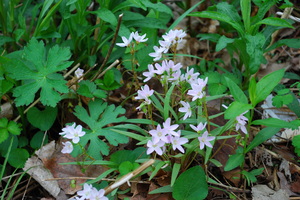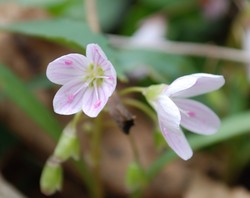A 'Spring Beauty' of a native plant

Spring Beauty (Claytonia virginica) brightens up a forest floor
Rick Meader|Contributor
Spring Beauty’s foliage is really not much to write home about. It has numerous straplike, leathery leaves that are easily mistaken for grass blades. In a lawn, or in a forest with a healthy sedge ground cover, you may only see the flowers unless you really get down on your knees. But, the flowers are worth getting your knees dirty. They’re only about ½ an inch in diameter, but the five petals sport tiny pink/lavender lines and pink anthers in an otherwise mostly white flower. For such a little flower, the detail is pretty impressive. It is primarily pollinated by bees and flies, with occasional visits by butterflies and moths. Once pollinated, the flowers form capsules, which release several little round seeds. The plant spreads around via these seeds.

The impressive detail of a delicate little flower
Rick Meader|Contributor
According to numerous accounts, it is most commonly found in rich woods. I have noticed them mostly in open oak forests not overrun with invasive shrubs like buckthorn and honeysuckle, but apparently they’re also common in moist to dry deciduous forests and savannas. You may even be lucky enough to have them in your lawn, if your house is situated in a formerly forested location and the land wasn’t bulldozed.
If you are lucky enough to be in such a situation, you may want to try holding off the mowing of at least a section of your lawn to see if any pop up. They’re a pretty durable plant, and you may find the little flowers popping up where you haven’t mowed. You don’t have to stop mowing all year, although if you do you might find other unexpected natives popping up as well later in the year, such as asters or goldenrods. Your yard may be waiting to present you with unexpected beauty, if you give it a chance. If you do, and all you get is dandelions or other nonnative weeds, you can always give up the experiment and hack it back later.
According to another account, Spring Beauty also has a pleasant floral scent, although I haven’t stuck my nose close enough to smell it yet. (I’ll try that tomorrow). It blooms for about a month, from April into May, and, being an ephemeral, the vegetation dies back during the summer. It’s not commercially available from local sources (and I always recommend buying from local sources who sell local genotype plants), but if you have a friend who has little pink flowers “contaminating” their lawn, perhaps you can relieve them of their burden by digging deep (at least four inches) to get the corm and bring it to a more welcoming environment, your garden.
Let me stop and say one more thing about this. Do not go into the wild and dig up plants for your garden, or anyone else’s. It may look like there is an unending supply of these plants, but there isn’t, and digging up plants is stealing. In some cases, the plants are also protected by law, but morals protect them anyway. Occasionally you may be able to get them from friends who have them on their property, or at plant exchanges, or by buying them from reputable dealers. Occasionally there are plant rescues where sites that will be developed are opened up to groups to get plants they want that would otherwise be lost to the brush hogs or bulldozers. Those are all acceptable means of obtaining native plants. In the meantime, enjoy them where they are, in habitats where they belong and thrive. I know it can be tempting (believe me, I know) to want to visit a neighbor’s yard or a local woodlot late at night to dig up little flowers that would look great in your yard, but don’t do it!
Okay, I’m off my soapbox. Right now, I have rue anemone, spring beauty, trillium, spicebush (on its last blooms), redbud, Virginia bluebells, Graceful sedge, Pennsylvania sedge, Canada anemone, wild strawberry, fragrant sumac, Early meadow rue and Wild geranium blooming in my yard. Jack in the pulpit is almost there, as is my carrion flower vine.
Get out and enjoy nature, everyone!
Rick is a local landscape architect with a special interest in all things natural, including native plants and the critters that eat them. You can contact him at yourland1824@gmail.com.


Comments
Rick Meader
Thu, Apr 29, 2010 : 10:05 p.m.
Thanks for your comments, you two! Rick
Rork Kuick
Wed, Apr 28, 2010 : 8:21 a.m.
Excellent, on both the plant, and the ethics. My "lawn" and woods (sandy, white oak dominated) are full of it, and I agree with the mowing advice. I apply nothing to my lawn, which is one reason I haven't needed to mow it yet, and I use only physical means to remove unwanted guests - it's a pain, I admit, but I want to show my neighbors that not using chemistry doesn't spell disaster, and can be spectacular. My favorite weapon is a heavy 1.5 inch putty knife, which is cheap, durable, non-polluting, and highly specific while still being very broad-spectrum. Sadly, I sometimes only see the full spectacle on weekends, since spring beauty usually close up a bit by the time I get home in the evening. Same trouble with spiderwort.